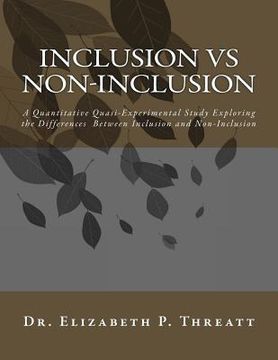Share
INCLUSION vs NON-INCLUSION: A Quantitative Quasi-Experimental Study Exploring the Differences Between Inclusion and Non-Inclusion (in English)
Elizabet P. Threatt
(Author)
·
Createspace Independent Publishing Platform
· Paperback
INCLUSION vs NON-INCLUSION: A Quantitative Quasi-Experimental Study Exploring the Differences Between Inclusion and Non-Inclusion (in English) - Threatt, Elizabet P.
$ 16.00
$ 20.00
You save: $ 4.00
Choose the list to add your product or create one New List
✓ Product added successfully to the Wishlist.
Go to My WishlistsIt will be shipped from our warehouse between
Thursday, July 04 and
Friday, July 05.
You will receive it anywhere in United States between 1 and 3 business days after shipment.
Synopsis "INCLUSION vs NON-INCLUSION: A Quantitative Quasi-Experimental Study Exploring the Differences Between Inclusion and Non-Inclusion (in English)"
This research study explored the differences between inclusion and non-inclusion placement relative to reading achievement as well as determined the relationship between teacher experience and teacher efficacy relative to reading achievement. Academic achievement was defined as a general education student's performance in reading as measured by the North Carolina End of Grade assessment. Analyses were conducted using ANOVA. The study included 130 fourth grade teachers from three school districts in Southeastern North Carolina. Results of this study indicated that general education students improved significantly in reading achievement from the third to the fourth grade when class type was not a factor. Results of this study also indicated that there is a significant difference in general education students reading achievement when class type is considered. During the third grade, students in inclusion classes scored significantly lower than students in non-inclusion classes in reading achievement when class type is a factor. Similarly, during the fourth grade, students in inclusion classes scored significantly lower than students in non-inclusion classes in reading achievement. Therefore further research is needed to determine why inclusion is having a negative impact on the achievement of general education students
- 0% (0)
- 0% (0)
- 0% (0)
- 0% (0)
- 0% (0)
All books in our catalog are Original.
The book is written in English.
The binding of this edition is Paperback.
✓ Producto agregado correctamente al carro, Ir a Pagar.

